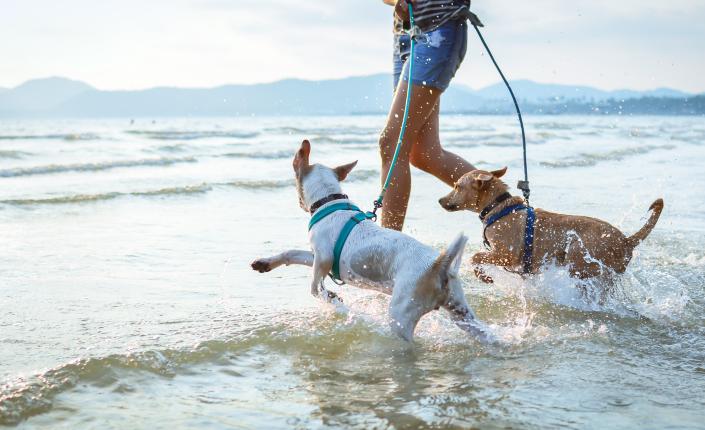
Pet-iquette 101: Dogs At The Beach
There’s nothing like walking barefoot in the sand as you soak up the rays on one of Canada’s many vast and sandy beaches. Just as kids and adults rush into the water on a hot day, some canine companions like to join us in a good romp or to cool off, too.
Before you grab your beach towels and frisbees, it's important to learn a thing or two about proper "pet-iquette" to ensure a paw-some time for everyone involved. So, let's dive in and explore how to make the beach a tail-wagging paradise for our furry companions!
Here are a few to keep in mind the next time you’re out with your dog at the beach:
Read the Signs
We all want to include our four-legged friends in our beach adventures, but sometimes we encounter those dreaded "No Dogs Allowed" signs. As disappointing as it may be, it's important to respect these rules and prioritize the safety and enjoyment of all beachgoers. Here's why:
Safety First
These signs may be posted to prevent accidents, conflicts, and potential harm in crowded areas, wildlife preservation areas, or other potential hazards where dogs could be at risk.
Environmental Preservation
Many beaches have delicate ecosystems that are easily disturbed by the presence of dogs. These ecosystems are home to various plants, animals, and habitats that need protection from outside disturbances.
Consideration for Others
Not everyone is comfortable around dogs. Some may have allergies, while other beachgoers may have had negative experiences with dogs in the past.
If you encounter a beach with a "No Dogs Allowed" policy, remember there are still plenty of dog-friendly beaches and alternative activities you can enjoy with your furry companion. Seek out designated dog-friendly areas, parks, or explore other outdoor adventures that accommodate dogs.
Take the Lead and Use a Leash
Ah, the feeling of sand between your toes as you stroll along the shoreline with your pup. But remember, not all beachgoers are comfortable around dogs, and some areas may require dogs to be on a leash.
Leashes are an important tool no matter how well-trained your dog is. Make sure your dog isn’t disrupting other beachgoers’ experiences or knocking over masterpiece sand castles by keeping them on a leash.
Keeping your furry friend on a leash is a matter of respecting others' space and ensuring their safety. With so many exciting smells and sights, it's easy for your pup to chase after wildlife or get into trouble. So, grab that leash, secure it well, and let the beach adventures begin!
Be Good to Go With H₂O
Can you imagine how hot and thirsty you would get with a full coat of fur? Always remember to bring enough drinking water for you and your dog. Even with so much water around, you’ll want to be prepared — drinking from lakes and oceans is unhealthy for your dog. In some cases, it can increase dehydration.
If necessary, you can purchase bottled water from a local shop or concession stand, but it will likely be more expensive than tap water from home. Bonus points if you’re extra prepared and can help when you meet another thirsty pup.
Keeping Your Pup Hydrated
The amount of water dogs need depends on age, activity level, and the weather. On average, most dogs need about one ounce of water for each pound of their body weight every day. Senior dogs, puppies, and toy breeds may have a higher risk of dehydration.
Some signs of dehydration include dry nose or gums, panting, decreased activity, loss of appetite, and sunken eyes.
To keep your pet healthy, monitor your dog’s liquid intake throughout the day and encourage them to drink often. With all the new smells and distractions of the beach, they may sometimes forget they're thirsty.
Respect the Environment
Remember, the beach is not only a playground for our furry pals but also a fragile ecosystem. Let's be responsible pet owners and do our part in preserving the beauty of our beaches. Here's how to make sure you and your pup “leave no trace”:
Avoid Dune Areas
To preserve the dune ecosystem, sticking to designated paths and avoiding off-path areas is important. Doing so can minimize our impact on delicate plants and wildlife inhabiting this fragile environment.
Don’t Bring Toys That Can Harm the Environment
When taking your dog to the beach, it's important to choose environmentally friendly toys that won't contribute to pollution. Avoid using items easily lost or left behind on the beach.
Clean Up After Your Dog
Stepping in doggy-doo is bad enough, but it's truly disgusting when you're barefoot. Avoid subjecting others to this by making sure they do their business before you hit the beach. Otherwise, watch for their tell-tale signs that they need to go and head over to a more suitable, grassy area.
If you're too late to react and your dog does his business on the beach, clean it up right away. Pour water over it and cover it with fresh sand to be extra safe. Other beachgoers will appreciate the extra precautions.
Seek Out a Quiet, Secluded Spot
With our shorter summers, beaches can get packed on nice days. With your furry friend in tow, try to keep to an area with fewer people and, ideally, more shade. It ensures everyone is more comfortable, and you won’t need to spend your day worried that a happy bark might create a disturbance. Plus, it gives you more room for a game of fetch.
Here’s to Pawsitive Beach Vibes
You and your furry friend can have an absolute blast at the beach while staying safe and respecting others. So your beach towels and frisbees, and let the tail-wagging adventures begin.
Looking for other opportunities for safe summer fun? Check out our guide on all the hiking essentials you need for your next adventure, or the top pet products for summer.
